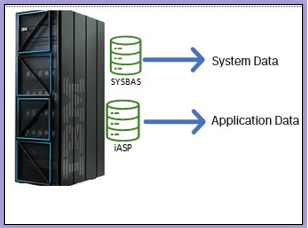IASP refers to Independent Auxiliary Storage pool. It is also known as independent disk pool. It is basically a collection of disk units which forms a separate storage pool which can be brought offline or online without impacting the system default storage or system ASP. Auxiliary storage is the permanent disk space that we assign to the system in the form of disk units which of course can be physical or virtual.
The disk pool can contain objects, libraries, directories and many other objects such as object attributes and many others. The concept of IASP also form a base for the HA or DR solutions like PowerHA . The concept of IASP is very straightforward and there are many solutions build around this. This concept is very attractive for the clients who are looking server consolidation and continuous availability with minimum amount of downtime as possible. It does provides technical and business advantages on IBM i. The key difference between the system auxiliary storage pool and IASP is that system asp is always accessible when system is up and running and while IASP can be brought online or offline independent of the system activity on the other pools. The activity of «varying on» the IASP is a pre-requisite before making any attempt to access data on it. The act of making the data visible on IBM i is called «Varying On» the IASP. Similarly, the act of making data inaccessible is called Varying off the IASP. The Vary-on itself is not instantaneous and can take few to several minutes depending on other factors.

Independent ASPs are always number from 33 through 255 while the basic ASP’s are always numbers 2 through 32. These basic ASP’s cannot be independently varied on/off and is always available when system is online. Please refer to Fig. 1.2 showing these.
It can be deployed on the external storage which is referred as SAN and also possible with the internal disks. However, there are many benefits of using SAN combines with IASP as many cluster configuration is possible here with the use of replication technologies available on the SAN . There are many clients already running this implementation when it comes to Manufacturing, Banking, Retail and much more. Some of the major ERP applications like J.D Edwards, SAP, M3 etc is already using it.

Types of IASP :
An independent disk pool can either be :
- Switchable: This is the IASP which is used across two or more IBM i partitions in a clustered environment. When the switch occurs and the independent disk pool is «varied on», the entire contents on the IASP is available.
- Non-Switchable: This is the IASP which is created locally to the system and is not shared with any other system.
When considering IASP implementation business needs should be considered first and accordingly plan should be made to implement this in the client environment. At the application level you should have good understanding where the objects reside, who are the users and how the program and data is accessed. There is certain type of objects that are supported in IASP but it should remain in system ASP only in order to expect the normal behavior of the system. Some work management related changes will also take place with the introduction of IASP. Generally there are only two environments in which IASP can be used .
1. Single system environment:
In this case you can have an IASP on the local system. It can be brought online or offline without impacting other storage pools on the system or the need of Initial Program load (IPL). You can have this type of local system which contains multiple database on the IASP . It can be made available while system is active without the need to perform an IPL. The independent disk pool can remain offline until it is needed.
2. Multisystem environment;
In this case you can have IASP which is shared between the multiple IBM i partitions on the same system or different system at another location that are the members of the cluster. In this kind of setup, this IASP can be switched between these systems without the need of any IPL for any of the partition. This is quite a significant advantage because it allows continuous availability of the data.
Practical uses of IASP
1. Disaster recovery and High availability Scenarios:
When planning for any HA or DR solution, one of the key foundation in order to use PowerHA using Geographical mirroring, Hyperswap, metro or global mirroring is «IASP». This is one of the solution which gives you the continuous availability of data depending on the strategy you choose and avoiding the use of any software replication tool . This can also be combined with DB2 mirror for i where continuous availability is implemented by use of IASP for Integrated File System(IFS). There is very minimal maintenance required when this solution is implemented. The data can remain available to an application even in the case of system outage and based on implementation switchover is automated.
2. Data Isolation or Protection :
IASP can also be used when you want to divide data between multiple databases. It can also be used to store data that is accesses occasionally per business requirement. So, this IASP can only be brought online when needed and this also gives us a protection in terms of data access as it remains offline until needed and no one can access this portion of storage until it is varied on and have proper rights to access it.
3. Flash copy:
This is also a solution to the flash copy where flash is taken for the customer IBM i environment which delivers almost instantaneous copy of the data in the nearest possible time which can be varied on a separate partition using IASP. This environment is now available to access to get the save running to the physical or virtual tapes. The whole process here is automated with the use of IASP. Backup, Recovery and Media Services (BRMS) is full integrated with IASP to automate the full process and provides reporting.
Object types not supported in Independent disk pool on IBM i 7.5
| *AUTHLR | *CNNL | *DOC | *SSND |
| *AUTL | *COSD | *JOBSCD | *M36CFG |
| *CFGL | *CRG | *LIND | *USRPRF |
| *CSPMAP | *DEVD | *MODD | *S36 |
| *EDTD | *DSTMF1 | *M36 | *EXITRG |
| *PRDLOD | *FLR | *NTBD | *IGCSRT |
| *RCT | *NWID | *SOCKET | |


